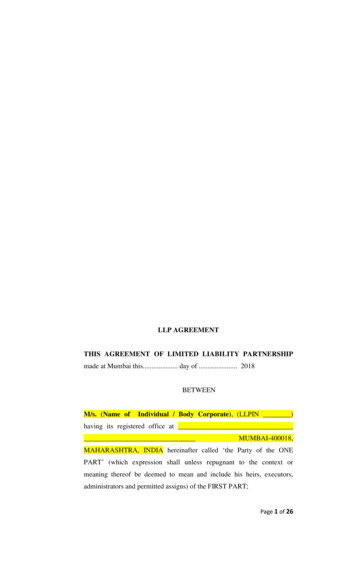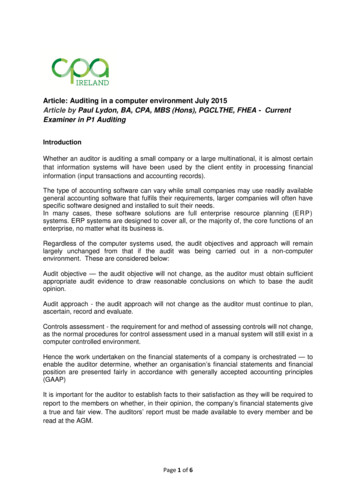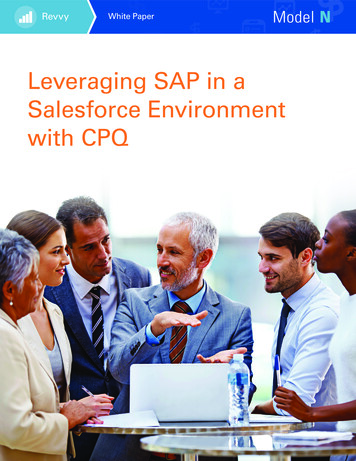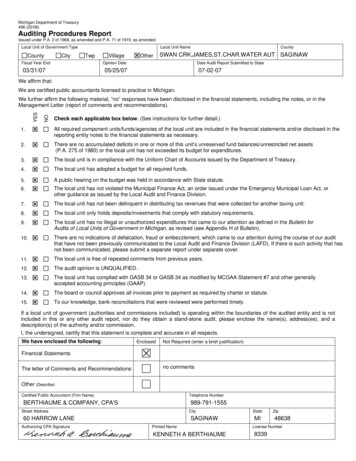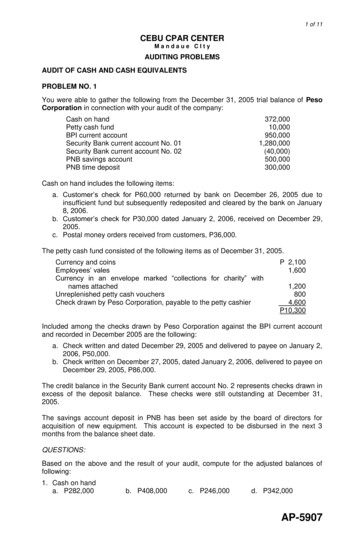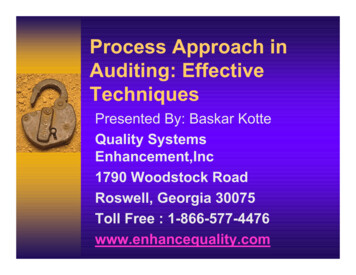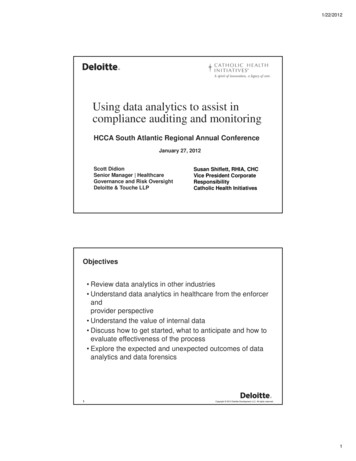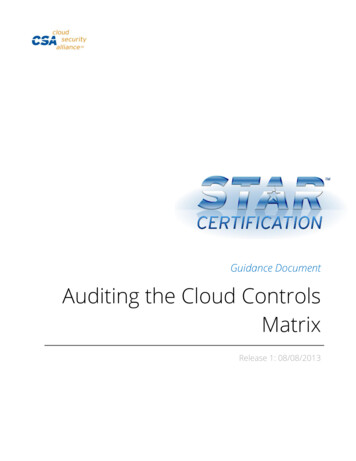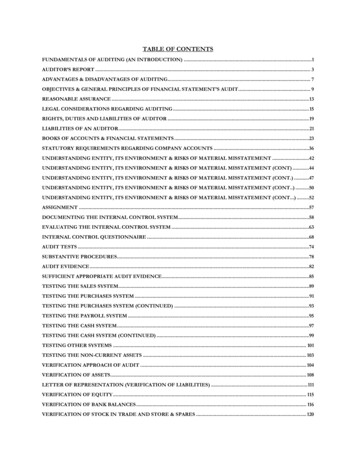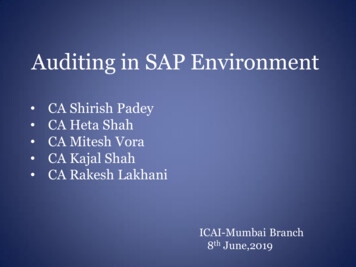
Transcription
Auditing in SAP Environment CA Shirish PadeyCA Heta ShahCA Mitesh VoraCA Kajal ShahCA Rakesh LakhaniICAI-Mumbai Branch8th June,2019
n to Controls based AuditIntroduction to SAPAccessing and Navigating SAPSAP OrganizationReview of IT General Controls (Other than BASIS)Review of SAP BASISValidation of Automated ControlsAuthorization ConceptSegregation of DutiesData Migration to SAPSAP UpgradeReport ValidationJE Extraction and AnalysisRobotic Process Automation (RPA) in SAP
SESSION 1Introduction to Controls based Audit
1.1 Standards on Auditing SA315 – Identifying and Assessing the Risk of MaterialMisstatement Through Understanding of the Entityand its Environment– The auditor shall Obtain understanding of Internal Controls Obtain understanding of Information Systems,including related business processes Obtain understanding of how the entity has respondedto risks arising from IT Obtain an understanding of the entity’s controls overrisk of inaccurate or incomplete recording oftransactions in highly automated processingenvironment SA330 – The Auditor’s Responses to Assessed Risk– The auditor shall Consider effectiveness of General IT Controls
1.2 Accounting in ERPs All entries are Journal Entries There are NO Primary or Secondary Booksof Account – only data stored in Tables
1.3 Difficulty in Substantive Auditfor ERPs Absence of PrintoutsVoluminous dataDifficulty in Ledger ScrutinyDifficulty in audit of “manual” journalentries
1.4 Alternative? Reliance on IT General Controls– Relying on Automated Controls andAutomated Accounting Procedures– Reliance on Reports and System-DependentManual Controls– Reliance on Underlying Data
Questions?
SESSION 2Introduction to SAP
2.1 SAP — What is it? SAP is a German multinational software corporationthat makes ERP with regional offices in almost 140 countries and has over approx. 437,000 customers in180 countries. In German: Systeme, Anwendungen und Produkte in derDatenverarbeitung In English: Systems, Applications and Products in Data Processing Founded in Walldorf, Deutschland (Germany), 1972 Not "Sap" — It is "S - A - P"
2.1 SAP — What is it? . [Contd.]
2.2 SAP - The Product R/3 and ERP Three tier architecture — Front end (GUI), Application Server,Database Server
2.2 SAP — The Product . [Contd.] Client — Server Architecture
2.3 R/3 and ERP: Three-Tier Computer Central Database(Storage of all data) Access to Dataase:(Read /Write data) Database Processing of datausing application logic Application Presentation Presentation of theprocessed data tothe user
2.4 Transport System SAP System SAP System SAP System Change Request DevelopmentQuality AssuranceProduction Moving changes from one system to another
2.5 SAP S/4 HANA Journey
2.6 Modules in SAP
2.6 SAP Modules [. contd .] SAP-FI (FInancial Accounting) SAP FI - General Ledger (GL)SAP FI - Accounts Payable (AP)SAP FI - Account Receivable (AR)SAP FI - Bank Accounting SAP-CO (COntrolling) SAP CO - Cost Element AccountingSAP CO - Cost Center AccountingSAP CO - Activity-Based CostingSAP CO - Product Cost ControllingSAP CO - Material Ledger SAP-SD (Sales & Distribution) SAP SD - Master DataSAP SD - SalesSAP SD - ShippingSAP SD - TransportationSAP SD - BillingSAP SD - Electronic DataInterchange (EDI) SAP-MM (MaterialManagement) SAP MM - PurchasingSAP MM - Inventory ManagementSAP MM - Warehouse ManagementSAP ML - Material Ledger
2.6 SAP Modules [. contd .] SAP-PP (Production Planning) SAP PP - Material RequirementsPlanningSAP PP - Capacity RequirementPlanningSAP PP - Sales and OperationsPlanningSAP PP - Production ordersSAP DS - Detailed Scheduling SAP-PS (Project System) SAP PS - PaymentsSAP PS - ConfirmationSAP PS - CostsSAP PS - ResourcesSAP PS - DatesSAP PS - Documents SAP-HR (Human Resource) SAP PA - Employee ManagementSAP PA - Personnel AdministrationSAP PA - BenefitsSAP PA - PayrollSAP PA - Time Management SAP-QM (Quality Management) SAP QM - Quality PlanningSAP QM - Quality InspectionprocessingSAP QM - Quality controlSAP QM - Test equipmentmanagement
2.6 SAP Product – features SAP Supports· Multiple Languages· Multiple Currencies Proprietary (High-level) Programming Language — ABAP(Advanced Business Application Programming) Can execute on any Operating System — UNIX,Windows etc. Can use any Database — Oracle, MS SQL, MS Access , SAPHana Currently, no Support for versions other than SAP R/3ECC (ERP Central Component ) 6.0 and SAP HANA
2.7 SAP – Points to Ponder Highly integrated On-line, Real-time Complex Data Structures Causes business process changes Causes organizational changes Very sophisticated testing of functionality and standard reports In-Built Controls Debit Credit tallyTrail of all transactions entered
2.8 SAP Business one SAP Business one — for Small / Medium Enterprises Not much complex as well as Not expensive ascompared to SAP R/3 Menu driven and NOT T-code (Transaction Code)driven as SAP R/3 Not much customization is possible No modules needs to buy entire package andRestrictions can be done on the basis of Licensepurchased Generally unable to rely on automated controls
Questions?
SESSION 3Accessing and Navigating SAP
3.1 Accessing SAP NEVER ACCESS LIVE ENVIRONMENTwith INSERT/EDIT/DELETE RIGHTS Log-on only with "READ ONLY" Access
3.2 Logging On -SAP GUI To log on to an R/3 system with the SAP GUI, one need theproprietary SAP GUI (Graphical User Interface) softwareloaded on your system and an internet /network/VPNconnection Account on SAP R/3 System at Data Centre or hosting site Internet / Network, VPN Connection PC with SAP GUI
3.3 SAP GUI Configuration First, you need to tell the SAP GUI which system you want to log into:
3.4 System Definition Text description (free) Address of system (e.g. sapd.umsystem.edu) System Number System ID Logical name of systemRouter (usually notrequired ) SAP
3.5 Configured SAP GUI SelectSystem: double-click or Logon button
3.6 Logging On Enter Client Enter User Enter Password Don't worry about language— English will default in
The default screen is called the SAP Easy Access Screen. You can switch from one menu to the other by selecting theappropriate icon When you log on, you will see either your user menu (specific toyour role), or the SAP standard menu (lists all transactions) 3.7 SAP MenusSAP User MenuSAPStandardMenu
3.8 SAP Navigation: Using the System Two ways to choosea task: Clicking on themenu option Enter atransaction codein the commandfield
3.9 SAP Screen Components Title Bar SAP Menu Standard Toolbar Buttons Navigation icons Command Field Favorites Caution: on your DependingGUI version, the screen may look different even if the SAP version is the same! Application Toolbar Message Bar Status Bar
Questions?
SESSION 4SAP Organization
4.1 SAP R/3 Organization Structure
4.2 SAP Organization Instance — One installation Client — At least one Client per Instance Company Code At least one Company Code per Client Generally a legal entity Trial Balance can be drawn at this level Cross Instance settings are not possible Cross Client settings are possible Cross Client consolidations are possible Some data can be defined at Client level, will applyto all Company Codes of that Client
4.1 SAP Organization Contd. Business Area — across Company Codes Plant — assigned to a single Company Code Purchasing Organization Sales Organization Very difficult to change SAP Organization afterimplementation Definition is extremely important forfunctionalities and security
4.2 SAP Organization Impact on Audit Appropriate scoping New GL for Multiple Reporting(s) — IFRS, ForeignReporting, Statutory and Tax Reporting Consolidations
Questions?
SESSION 5Review of IT General Controls(Other than BASIS)
5.0 IT General ControlsITGCs may also be referred to as GeneralComputer Controls which are defined as"Controls, other than application controlswhich, relate to the environment withinwhich computer-based application systemsare developed, maintained and operatedand which are therefore applicable to allapplications”
5.0 IT General Controls ITGCs cover 5 domains –––––IT GovernanceAccess to Programs and DataChange ManagementProgram DevelopmentComputer Operations The objectives of general controls are to ensure the properdevelopment and implementation of applications, theintegrity of program and data files and of computeroperations. Like application controls, general controls may be eithermanual or programmed.
5.1 IT Governance Management controls over IT IT Organization structure, including definition ofroles and responsibilities within IT Policies and Procedures, e.g.––––IT Security PoliciesChange ManagementInfrastructure maintenanceHR Policies Regulatory compliance Audit issues management
5.2 Access to Programs and Data Provisioning and modification of end-useraccess (SAP, Operating Systems, Databases,Networks) Timely revocation of user access(resigned/absconded users) Privileged access to SAP, Operating Systems,Databases, Networks Physical Accesses (access to data center,computing facilities, environmental controls) Password parameters
5.2 IT Risks within Access to Programsand Data User access is provided withoutappropriate prior approvals User access for terminated employees isnot removed in a timely manner User access is appropriately updated toreflect changes to individuals roles andresponsibilities Access to the system is restricted throughcomplex password parameters
5.2 Auditing in SAP Verify that access to critical system (application,operating system and database) functions isappropriately restricted on an as-needed basis Super-user profiles, i.e. SAP ALL andSAP NEW are not assigned to any user id Default SAP Accounts are locked and theirdefault passwords are changed Privileged (super-user) user access at theapplication, OS, database and network level isapproved Complex passwords are required at all levels
5.2 Auditing in SAP Logging is enabled at the system level andcritical configuration tables are logged Remote access (VPN, Web, etc.) isappropriately restricted and monitored User accounts that support internalprocesses, interfaces, job schedules, etc.are defined as system accounts (user types‘B’ or ‘C’) to prevent individuals from usingthose accounts
5.2 Auditing in SAP
5.2 Auditing in SAP
5.2 Auditing in SAP
5.2 Auditing in SAP
5.2 Auditing in SAP
5.3 Change Management Changes to application configurations,reports, programs Changes to Operating Systems, databasesand network Segregation of environments(development, test and production) Developer Access to live data is restricted
5.3 IT Risks within Change Management Unauthorized changes are made to theapplication, operating system, database ornetwork Changes are not tested sufficiently prior toimplementation in the production system
5.3 Auditing in SAP SAP environment is segregated into the 3-box system,i.e. development, testing/QA and production (live) Changes are adequately and independently tested andapproved before being implemented in the production Developers should not have access to production eitherthrough developer keys or through transactions. Production is locked for direct changes and is openedbased on specific approvals When direct changes are required in production, theyare made only through transport requests Business impact analysis of changes implemented
5.3 Auditing in SAP
5.3 Auditing in SAP
5.3 Auditing in SAP
5.3 Auditing in SAP
5.3 Auditing in SAP
5.3 Auditing in SAP
5.4 Computer Operations Batch Processing and schedulingInterface testingBackupDisaster Recovery and BCPNetwork security
5.4 IT Risks within ComputerOperations Failed batch jobs are not monitored andrescheduled Interfaces are not monitored System back-ups are not taken on a regular basis Back-ups are not tested for successful restoration Back-ups are not stored at an offsite location External access to the system is not appropriatelyrestricted Data center is not designed to prevent damage dueto heating, accidental fires, etc.
5.4 Auditing in SAP Access to batch scheduling and monitoring tools isrestricted to the IT operations team Access to back-up tools is restricted to the IToperations team Failed batch jobs, interfaces and back-ups are trackedthrough a ticketing system and are resolved Back-ups are stored at an offsite location and areperiodically tested for successful restoration External access to the system is appropriatelyrestricted through firewalls, etc. and periodicallytested
Questions?
SESSION 6Review of SAP BASIS
6.0 SAP BASIS reviewITGC Domain – Computer Operations Access to maintain (create new or change/delete existing) jobschedules is appropriately restricted Access to executed critical job schedules is appropriately restricted Critical batch jobs, especially those that have a financial impact, areidentified and are monitored Failed batches are monitored and resolvedThe above procedures apply like-wise to any interfaces that have beenset-up with external applications
6.0 SAP NetWeaver / Basis What is SAP NetWeaver / BasisRole of SAP Basis team memberIT Risks within SAP BasisSAP Basis review
6.1 What is SAP NetWeaver /Basis?SAP ApplicationSAP NetWeaver / BasisDatabaseOperating SystemHardware
6.1 What is SAP NetWeaver /Basis? NetWeaver is a toolkit used to enhance businessfunctionalities delivered by SAP components. Often interchangeably referred to as SAP Basis(reference to the original toolkit that was thefoundation of SAP R/3). Act as a filter between the actual business logic in SAPR/3 and the specif
5.2 Auditing in SAP. 5.3 Change Management Changes to application configurations, reports, programs Changes to Operating Systems, databases and network Segregation of environments (development, test and production) Developer Access to live data is restricted. 5.3 IT Risks within Change Management.
